My medical Placement in India
Published on Thursday 26 May 2016My pre-university medical placement in India by Tish Jervis
Tish has very kindly sent us some extracts from her blog about her time with us in India. Tish is applying for graduate entry medicine and used her time with us in India to gain some valuable work experience.
April 25th: After a small delay at Heathrow Airport, my Jet Airways flight to Delhi took off with no problems. I managed to secure myself one of the emergency exits seats which is always a winner when your a 6ft giant and on an overnight flight. With a small bit of turbulence and 7 hours later we arrived in Delhi Airport where I had a 3 hour wait before my connecting flight to Trivandrum. I was absolutely starving at this point but with the shear fear of Delhi Belly and the only options for food being Yo China (interesting) and McDonalds, I settled for some crisps and India’s version of dairy milk (sadly no comparison to ours.) My next flight was a transit flight so went via Bangalore on its way to Trivandrum, where I finally arrived at 7pm on Thursday 21st April.
I was met by a very sweet young Indian man who drove me from the airport to the volunteer accommodation (45 minutes away.) Stepping out of the air conditioned airport into 38 degree heat and humidity was a bit of a shock, not the mention the exciting chaos, colour and smells that came with it. After nearly being knocked flat by an autorickshaw driver we headed for what would be my home for the next 4 weeks.
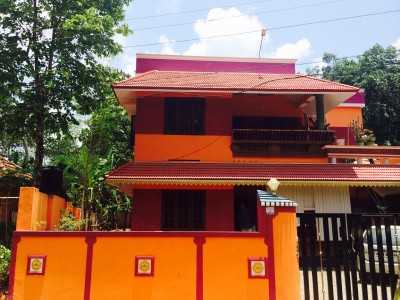 On arrival I was greeted by Babu (Head of the Global Volunteers Medical Project and Owner of the house) and Sudah (a very friendly lady who is Project Co-ordinator.) The house stood out from the surrounding greenery, due to its bright orange and pink colour. I was given a very warm and friendly welcome and then shown to my room before being cooked an Indian omelette for supper before heading to bed. Trying to sleep in 38 degrees with a fan blowing hot air isn’t easy and involves having at least 3 showers throughout the night.
On arrival I was greeted by Babu (Head of the Global Volunteers Medical Project and Owner of the house) and Sudah (a very friendly lady who is Project Co-ordinator.) The house stood out from the surrounding greenery, due to its bright orange and pink colour. I was given a very warm and friendly welcome and then shown to my room before being cooked an Indian omelette for supper before heading to bed. Trying to sleep in 38 degrees with a fan blowing hot air isn’t easy and involves having at least 3 showers throughout the night.
The next day began with a coconut Idiyappam curry with rice which was delicious and a good way to get straight into the Indian culture. A tailor lady came to the house to take my measurements and we went shopping for fabric from which she kindly made me two typical Indian woman’s outfits to wear during my placements in the hospital. I spent the rest of the day checking out the local area, finishing with supper in the nearby Indian Coffee House.
On Saturday I drove with Babu to his doctors appointment in a primary care clinic in a hospital 1 hour away from the house (Nirmala Hospital.) I met Dr Sreejith who is a primary care doctor with a specialist interest in Paediatrics and Diabetes. I then spent the afternoon in the local beach resort where you can pay the equivalent of 10 pounds (1,000 rupees) to use the pool and other facilities and have a delicious buffet supper at the end of the day. I watched the sunset from the beach outside the resort and then headed home by autorickshaw after supper.
Sunday began with a trip to church with Sudah followed by a visit to the disabled girls orphanage and convent. This was a rather amazing experience and I felt very honoured to meet all of the girls who all had beautiful smiles. I will come back in the evenings during my placement to help them with physiotherapy, meal times and learning how to read and write in English. In the afternoon Babu, Sudah and I drove to Varkala Beach to watch the sunset and walk along the cliff tops. From here we met another doctor friend of Babu’s who is a Gynaecologist in Kerala and went for some puttu (steamed cylinders of rice, filled with spiced vegetables) for supper before heading home.
After a weekend of getting used to everything I will start my placement tomorrow morning!
May 2nd: I began my placement with 3 days at a Primary Care Hospital in Trivandrum. Nirmala Hospital is a privately run hospital that is made up of a clinic room, emergency room and a 10 bed admission ward. During my time here I shadowed a General Practitioner with a specialist interest in diabetes (Dr Sreejith.) Morning clinic here runs from 9-1pm with the main cases being seen involving infection, diabetes and allergy and asthma. It was quite notable how many of the population suffer from diabetes due to a diet rich in carbohydrate and sugar. I learnt alot about the healthcare system in India and the coexistence of government run and private/corporate hospitals. A visit to this private GP costs 130 rupees which is the equivalent of just over 1 pound. Patients then have to pay for any further investigations required and any medicines needed. Pharma companies visit daily to delivery physician samples of particular drugs that they are advertising. The clinicians keep these samples and give them to patients free of charge, for those who cannot afford prescription medications.
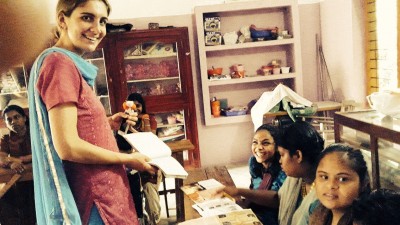 On my first day I learnt how to take blood pressure using a sphygmomanometer and a stethoscope. I had practiced this once on a nurse before the doctor sent me into the next room and asked me to measure the blood pressure of every patient before they came to see him (in at the deep end, but I learnt quickly!) Tuesday followed a similar pattern, observing in the primary care clinic. Although very sadly an emergency case came in on Tuesday evening (16 yr old boy, drowning incident) and sadly he was unable to be resuscitated! The rip currents off the coast of India are particularly strong. On Wednesday, as well as attending the morning clinic, I was invited to Dr Sreejith’s house for a delicious chicken biryani before shadowing his specialist paediatric clinic in SK hospital. I met his lovely wife who is a dentist, his parents and his two little boys. They were all very welcoming and happy to see me. At the SK hospital most cases involved allergy, asthma, bronchitis, bacteria enteritis and chickenpox. I also got to briefly visit the labour ward and neonatal unit where I met a very tiny baby who had been born prematurely at 25 + 2 weeks. I then attended the evening clinic back at Nirmala Hospital (5-8pm.) I learnt a huge amount whilst shadowing Dr Sreejith and it was very clear that the health system out here is much more doctor led with less patient involvement in the plan of care as opposed to the system we have at home. It was also interesting to see how much of the consultation time was spent educating patients in regards to diet or inhaler therapy (most patients have a fear of inhalers for various reasons.)
On my first day I learnt how to take blood pressure using a sphygmomanometer and a stethoscope. I had practiced this once on a nurse before the doctor sent me into the next room and asked me to measure the blood pressure of every patient before they came to see him (in at the deep end, but I learnt quickly!) Tuesday followed a similar pattern, observing in the primary care clinic. Although very sadly an emergency case came in on Tuesday evening (16 yr old boy, drowning incident) and sadly he was unable to be resuscitated! The rip currents off the coast of India are particularly strong. On Wednesday, as well as attending the morning clinic, I was invited to Dr Sreejith’s house for a delicious chicken biryani before shadowing his specialist paediatric clinic in SK hospital. I met his lovely wife who is a dentist, his parents and his two little boys. They were all very welcoming and happy to see me. At the SK hospital most cases involved allergy, asthma, bronchitis, bacteria enteritis and chickenpox. I also got to briefly visit the labour ward and neonatal unit where I met a very tiny baby who had been born prematurely at 25 + 2 weeks. I then attended the evening clinic back at Nirmala Hospital (5-8pm.) I learnt a huge amount whilst shadowing Dr Sreejith and it was very clear that the health system out here is much more doctor led with less patient involvement in the plan of care as opposed to the system we have at home. It was also interesting to see how much of the consultation time was spent educating patients in regards to diet or inhaler therapy (most patients have a fear of inhalers for various reasons.)
I spent Thursday and Friday at St. John’s Medical College, Community Hospital. On Thursday I shadowed in the paediatric clinic from 9-1pm. Dr Preethi Menon (Consultant Paediatrician) taught me a large amount about observation in young children, respiratory distress and the main illnesses that she sees: allergy, abuse, croop, epilglottitis, fungal rash, asthma and infection. I observed a young boy with dysentry on the observation ward and visited an older boy who was suffering from a high grade fever amongst other things associated with dengue fever. On Friday I observed the haemodialysis unit, where patients with Chronic Kidney Disease (CKD) receive dialysis 2 times a week, with each session lasting 4 hours. The staff nurse on this unit were very friendly and explained to me exactly how the dialysis machines work and the causes of CKD and any complications of dialysis. Each dialysis session costs the patient 700 rupees which is the equivalent to 7 pounds. Many of the patients on this unit suffered from oedema and breathing difficulties due to fluid accumulation as a result of their disease. One of the gentlemen having his dialysis at the time was particularly friendly and kept calling me ‘giant princess.’ I decided to take that one as a compliment as he had managed to rectify his use of the masculine word giant, with a more feminine princess.
During the afternoons Babu, Sudah and I visited the Lake Palace Hotel for tea, cooked delicious curries at home, played cards with the little boy who lives next door and went shopping at the markets. I now know how to make a delicious vegetable and coconut curry so I will try my best to recreate this when I get home.
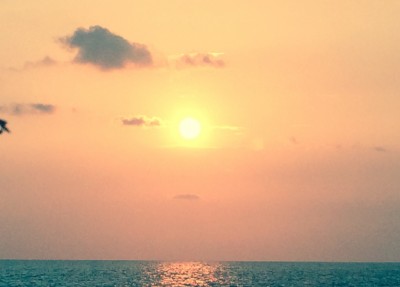 On Friday evening I went to Waters Edge Beach Resort of Samudra Beach, Kovalam. Here I spent the weekend in the sun, enjoying some fishing and swimming. I returned back home to the volunteer house on Sunday evening after a 2 hour rickshaw ride. I think it is fair to say that the 4 car wide overtake that they seem to have adopted quite readily out here on the roads is LETHAL. All I know is if I had taken my driving test in India I certainly would have passed first time, instead of fifth!
On Friday evening I went to Waters Edge Beach Resort of Samudra Beach, Kovalam. Here I spent the weekend in the sun, enjoying some fishing and swimming. I returned back home to the volunteer house on Sunday evening after a 2 hour rickshaw ride. I think it is fair to say that the 4 car wide overtake that they seem to have adopted quite readily out here on the roads is LETHAL. All I know is if I had taken my driving test in India I certainly would have passed first time, instead of fifth!
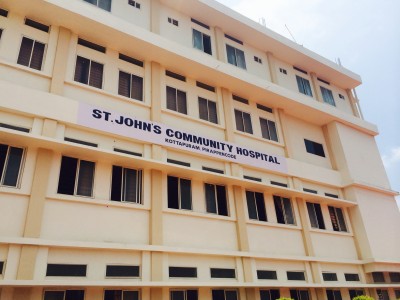 May 8th: Another week has flown by out here where I spent my time in St. John’s Community Hospital shadowing various specialties. On Monday I split my time between shadowing a GP and an ENT consultant. Cases seen in general practice included throat and chest infections, lower leg oedema and diabetic complications. Time in ENT was really interesting and I certainly learnt that small toddlers will find anything to put up their nose. In one morning the consultant removed 2 pearls, one ball of paper and a pea from various toddler’s noses. Aside from foreign objects stuck in orifices, other cases included otomycosis (fungal infection of the outer ear), thyroglossal cysts, surgery to repair the ripped earring hole of an elderly woman, tonsilitis, acute superior otitis media (inflammation of the middle ear) and rhinitis (inflammation of the membrane inside the nose.) The ENT consultant spoke very good English and was able to explain a great deal to me, for which I was very grateful.
May 8th: Another week has flown by out here where I spent my time in St. John’s Community Hospital shadowing various specialties. On Monday I split my time between shadowing a GP and an ENT consultant. Cases seen in general practice included throat and chest infections, lower leg oedema and diabetic complications. Time in ENT was really interesting and I certainly learnt that small toddlers will find anything to put up their nose. In one morning the consultant removed 2 pearls, one ball of paper and a pea from various toddler’s noses. Aside from foreign objects stuck in orifices, other cases included otomycosis (fungal infection of the outer ear), thyroglossal cysts, surgery to repair the ripped earring hole of an elderly woman, tonsilitis, acute superior otitis media (inflammation of the middle ear) and rhinitis (inflammation of the membrane inside the nose.) The ENT consultant spoke very good English and was able to explain a great deal to me, for which I was very grateful.
On Tuesday I visited the Leprosy Centre that is attached to St. Johns, where treated leprosy patients are offered physiotherapy and reconstructive surgery to help correct for hand and feet complications as a result of the nervous system involvement in leprosy. Here I spent time with the physiotherapist, meeting the patients staying in the centre and observing their physio sessions. When I arrived the physio had very kindly put together a powerpoint presentation in English for me that taught me about leprosy, its causes, its complications and its treatment. This was really interesting as it is not a disease regularly seen in the UK. The majority of the patients staying in the centre are there for care of their ulcers that usually develop due to loss of sensation in various parts of the body, leading to the inability to feel heat or pain. This can often result in ulcers, that if left untreated can reach as deep as the bone, causing further complications. Here in India they treat ulcers using SSOD: soaking, scrubbing, oiling and dressing. This reduces infection and leads to ulcer healing. Other common complications seen were foot drops and claw hands which are caused by the leprosy bacteria damaging the nervous system. It was very exciting watching a leprosy patient learn to weight bear and eventually take a few steps after foot surgery. Due to the stigma that exists in the community in regards to leprosy, the opportunity for reconstructive surgery (paid for by the government) is rather wonderful for these patients who face a lot of exclusion in their daily lives. I saw some amazing videos of some patients before and after surgery, and the real difference that it makes. The prevalence of leprosy in India used to be 60 per 10,000 but since the introduction of the Leprosy Elimination Action Programme this has dropped to <1 care per 10,000.
On Wednesday we drove to collect a dialysis patient from their home and took them to hospital for their treatment. I then spent the rest of the day helping on the dialysis unit. The patient that we collected suffers a lot financially and as a result, after his next 10 sessions of dialysis (currently covered by a government scheme) he will be able to pay for 2 sessions out of his own money before he and his family will not be able to afford his treatment anymore. Through a very kind donation from a colleague at Great Ormond Street we hope to try and help him and his family pay for his treatment for a little longer. We had visited him and his family at their home on Tuesday afternoon to talk to them about their situation and his illnesses. It is very sad quite how many people in India either don’t seek medical assistance in the first place or can’t complete their treatment due to financial problems. In the afternoon I visited the Cancer and Palliative Care Centre which was very moving. The most common type of cancer in Kerala seems to be leukaemia which they find very difficult to treat. I met 3 cancer patients and their families, one patient who had fallen from a tree and suffered lower body paralysis due to spinal cord damage and one patient suffering from whole body stiffness due to late stage Parkinson’s. This centre is very impressive and professionally run to ensure that all patients have a painless and peaceful end of life. The nuns regularly visit the patients and their families on this ward and there is a very beautiful chapel in the centre. On Friday I split my time between a GP with a specialist interest in palliative care and ENT.
In the evenings we visited Attingal market, tried many Indian baked treats, played cards with Kannan (who lives next door), visited patients in their homes and went to Saigramam. Saigramam is a non profit organisation that is rather beautiful and includes an orphanage, an old people’s home, some amazing temples, an art village and a cow farm. We walked around the grounds and visited the children in the orphanage and the old people’s home. I met a little boy called Sadheesh who is 5 years old and who’s parents had both sadly died in an accident. He was definitely King of the Orphanage and had the worlds biggest smile. A lot of the children here do still have parents but they can’t afford to look after them. This means that every once in a while they do go home for a visit which is nice.
Babu (Project Co-ordinator) left for the UK on Monday to see his family so I am now being very well looked after by Sudha (Project Mediator) and Deepak a nursing student who is currently sitting his entrance exams for medical school which seem to be very tough out here. I have also spent a lot of time with some of Deepak and Sudha’s friends, mainly Dipin and his wife Rumie who are both very lovely. I am very excited to meet their 2 year old daughter this week.
After a relaxing weekend on the beach, it is back to work again tomorrow. The focus for this week is gynaecology, obstetrics and paediatrics. My dream!
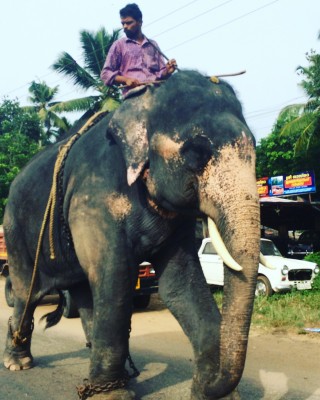 May 15: This was my favourite week so far. I think this was mainly because I was placed in Anchal Hospital for Mother and Child which is heaven when you are as obsessed with small babies as I am. On this route from home to work I saw a fair few elephant commutes, which definitely beats the London tube anyday of the week!
May 15: This was my favourite week so far. I think this was mainly because I was placed in Anchal Hospital for Mother and Child which is heaven when you are as obsessed with small babies as I am. On this route from home to work I saw a fair few elephant commutes, which definitely beats the London tube anyday of the week!
On Monday morning I was placed in the outpatient department with a female Gynaecologist. In India the majority of gynaecologists are in fact female, whilst in the UK the majority are male. I began the morning in theatre watching Postpartum Sterilisation of a women who had given birth to her second child 3 days before and did not want anymore children. This was a very interesting operation to watch and it was rather insightful being exposed to surgery and the workings of the theatres in a country so different to our own. Once the operation was over and the patient had come round her 3 day old baby came for a feed and I got to hold him afterwards which made my day! In the afternoon I shadowed a consultant paediatrician who spoke brilliant English and explained each case to me in great detail. The main illnesses seen here were fever, abdominal pain, constipation, loose bowels, allergy and asthma, skin rashes, dengue, mumps, abscesses and the added extra of ear piercing. I helped hold down a little 4 year old boy on the emergency ward whilst they cut open and drained an abscess that he had on his hair line (poor little thing!) Following this I did the ward round with the paediatrician where I met a newborn baby with jaundice who was receiving phototherapy and a number of children with high grade fevers. I stayed with the gynaecologist and paediatrician for the rest of the week and also spent some time with the nurses on the wards.
Tuesday’s gynaecology experience brought a lot of ultrasound scans, cases of gestational diabetes, down syndrome tests using ultrasound (by measuring the nuchal translucency and development of the nasal bridge), UTIs, gestational nausea and the removal of fibroids. In India they usually do a pregnancy scan at 6-7 weeks (to see intrauterine growth), 11-12 weeks (to check development of the nasal bridge), 20 weeks (to check foetal growth), 36 weeks (to monitor placenta function.) In India foetal sex determination is illegal so every baby is a surprise sex wise which is quite exciting. In the afternoon the paediatric outpatients was very quiet so I spent my time on the wards with the nurses. One particular nurse called Sumi was lovely and asked me to teach her some English words as we went around. On the ward I saw abdominal burns, jaundice babies, IV cannulation, upper respiratory infections and a lot of children with fevers. At about 3 pm one of the water pipes in one of the patient’s bedrooms burst and water was quite literally pouring everywhere with the whole first floor flooded within minutes. Patients were being treated in the corridors and the lift as the water could not be stopped!!
Wednesday involved hypertensive patients, menorrhagia and ultrasounds in the gynaecology department. We discussed the risks of overweight and underweight mothers to both the mother and child during pregnancy. It was concluded that underweight mothers have a better prognosis due to the complications such as hypertension, thrombosis risk and gestational diabetes associated with overweight mothers. I then spent a bit of time in the casualty department with nurses Bincy and Sumi. It was very quiet and involved a few patients coming for injections for gastritis and insulin injections for diabetes. I then went up to the second floor to meet a baby who had been born the previous day. He was so tiny and the family asked me to hold him as they believe that a westerner holding their baby is a blessing (I certainly wasn’t complaining.) The paediatric department was very busy with a lot of children with fevers (common at this time of year), vaccinations, URTIs, nebulisation, mumps, dengue fever and very sadly the diagnosis of quite late stage meningitis in a very young little girl. I learnt a few Malayalam words (the language spoken in this state of Kerala): vedana (pain), dhala (head), mookk (nose), pani (fever) and chood (hot)-the spellings may not be quite right! At the end of the day I watched my first ever circumcision of an 8 year old boy under local anaesthetic (ouch!) In India boys usually have this done from birth to 4 years old.
Thursday was a very exciting day as I got to see my first delivery out here. I had spent the morning with the gynaecologist seeing patients for scans, incontinence, dysuria, infertility and polycystic ovaries. I had just begun with the paediatrician when I was called to the labour room. The patient had been in labour since 6 am and she was 2 hours away from having to have an emergency caesarean but luckily the baby decided it was time. Here they give prostaglandins to make the cervix soft and oxytocin to stimulate contractions. Two nurses were pushing on her tummy whilst the gynaecologist was helping the baby at the other end. I was far too close to all the action when the waters broke and was covered from head to toe but it was an amazing thing to see. It was very professional having the gynaecologist for the delivery and the paediatrician to examine the baby the second it arrives! Husbands and family are not allowed in the delivery room during the births.
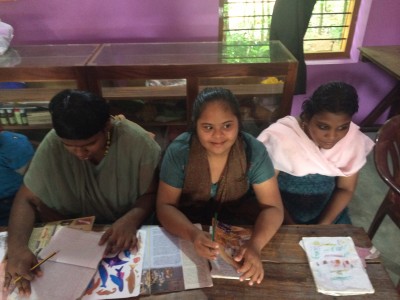 On Friday we visited the Bethania Rehabilitation Centre for the Disabled in Kumarapuram. This centre is run by Bethany Convent Sisters of Immaculate Christ. It is home to 70 girls from the age of 12-50 years old. The centre provides living and rehabilitation facilities with different sessions run daily for the girls. I was lucky enough to see an english lesson, a type writing class, paper card making, tailoring and sewing, computer writing, handwriting and to visit the book printing and binding press attached to the centre. The girls were lovely and introduced themselves and the town in which they lived. One girl did the most beautiful dance whilst another sang a song for me. During the typewriting, computer writing and handwriting lessons they were copying from english text about pollution which was very impressive. This centre is free of charge and is a rather amazing facility for these girls to learn different skills and rehabilitate. We then went into Trivandrum to purchase a wheelchair that we are donating to a dialysis patient who struggles financially and who can very sadly no longer walk very far. After this we visited Pallium India which is a hospital for pain management and palliative care where I will be placed for a few days next week. It focuses on ‘care beyond cure’ and has a lot of patients suffering from spinal cord injury. Next week I will visit the clinical hospital and go on home visits with the community palliative care team.
On Friday we visited the Bethania Rehabilitation Centre for the Disabled in Kumarapuram. This centre is run by Bethany Convent Sisters of Immaculate Christ. It is home to 70 girls from the age of 12-50 years old. The centre provides living and rehabilitation facilities with different sessions run daily for the girls. I was lucky enough to see an english lesson, a type writing class, paper card making, tailoring and sewing, computer writing, handwriting and to visit the book printing and binding press attached to the centre. The girls were lovely and introduced themselves and the town in which they lived. One girl did the most beautiful dance whilst another sang a song for me. During the typewriting, computer writing and handwriting lessons they were copying from english text about pollution which was very impressive. This centre is free of charge and is a rather amazing facility for these girls to learn different skills and rehabilitate. We then went into Trivandrum to purchase a wheelchair that we are donating to a dialysis patient who struggles financially and who can very sadly no longer walk very far. After this we visited Pallium India which is a hospital for pain management and palliative care where I will be placed for a few days next week. It focuses on ‘care beyond cure’ and has a lot of patients suffering from spinal cord injury. Next week I will visit the clinical hospital and go on home visits with the community palliative care team.
In the evenings I planned for the rest of my time out here with Emily and Lottie, was thrashed again and again by Kannan at chess and got to meet Dipin and Rumie’s beautiful little daughter Anna!
Beach for the weekend which was very stormy with some seriously impressive lightning. Tomorrow is election day in Kerala which they have been counting down to and campaigning for for a while now. It is the election for the fourteenth legislative assembly to elect representatives of the 140 constituencies in Kerala.
May 20: My final week began with election day in Kerala which was extremely full on but very cool to experience. All the campaigning before and the celebrations afterwards were a lot of fun! As a result of such celebrations all roads are a nightmare so we spent the day watching it all from the balcony and eating delicious pancakes with maple syrup. In the evening we got a rickshaw to see a dialysis patient Sudhkaran and deliver him his wheelchair. He was so happy to receive this as this means that his wife can now take him to hospital for his treatment by wheelchair and bus instead of on the back of a motorway (which is risky business in Kerala.) Unfortunately he lost the use of his face muscles after his first stroke so in the photos below he may not look very smiley but he loved it and wanted to get in it straight away!
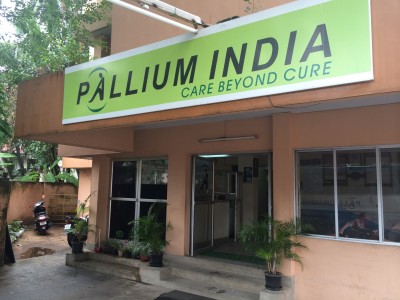 Tuesday and Wednesday I spent at Pallium India Hospital for palliative care (care beyond cure.) This hospital deals with lifelong illnesses, pain management and palliative care. I spent Tuesday at the hospital shadowing doctors and nurses and on Wednesday I went with the team on the home care visits. Whilst on the in patient ward I saw a patient with a giant cell tumour in her left ileum, a women with a neck ulcer that had become infected with maggots (that morning the nurse had removed 100 maggots from her neck!) and an elderly man with cancer of the oropharynx. This inpatient ward can accommodate up to 15 patients but on this day it was relatively quiet. I learnt a lot on the ward rounds with the doctors, especially about the different types of pain management used and the side effects that different patients experience. The most common being delirium following the administration of morphine. Most patients are discharged back home once their pain is under control unless they have chosen to stay until their last few days, in which case these days are made as peaceful as possible. The hospital also runs a rehabilitation program for people with paralysis. This is a collaborative project of Pallium India with the Department of Social Justice, Government of Kerala. The centre can accommodate up to 4 patients at once and each patient usually comes for 45-50 days of rehabilitation. Whilst I was visiting there was a young boy with hemiplegia (paralysis of one side of the body), a lady with a demyelinating disease and as a result had paraplegia and 2 young men also with paraplegia. The young boy spoke very good English and was an extremely talented little artist. He showed me all of his watercolour paintings with his masterpiece being an A3 Ferrari which was very cool. I spent a lot of time speaking to the social workers during lunch. One spoke very good English and is off to New Zealand next month which is very exciting for him as it will be the first time that he has left India. I met the chairman of the hospital who was a very lovely man and who spoke to me about medicine for a while. Wednesday’s home care visits begun at 8.30 am and included 7 different patients, finishing at 4 pm. The home care team involved 1 doctor, 1 nurse, 3 volunteers, me and a driver. All patients visited were either bed ridden or couldn’t access a hospital due to the remoteness of their house. The cases seen included oral cancer, lung cancer, hemiplegia, obstructive hydrocephalus, uncontrolled diabetes and geriatric patients. The doctor and nurse checked the patient’s vitals (pulse, blood pressure and chest) and replenished any regular medicines that the patients required. I got to perform my first chest auscultation on a patient and his wife gave me one of her jungle pineapples to say thank you which was very sweet. A lot of the patients lived up in Kerala’s jungle meaning that to get to them we had to park the mini bus and walk through the jungle, dodging falling coconuts from the trees above and crossing a few rivers. At one point a fast moving snake came straight across the path in front of me (you can see from the photo below that I wasn’t best pleased!) The patients seen all lived in stone huts with tarpaulin or tin roofs with minimal electricity supplies. On the trees surrounding their houses they engraved water run-off paths ending in coconuts to collect the rain water which is very clever! It was rather amazing being able to see these home visits and make comparisons to the ones that I have experienced in the UK in general practice (they certainly didn’t involve any jungle hikes or snakes!)
Tuesday and Wednesday I spent at Pallium India Hospital for palliative care (care beyond cure.) This hospital deals with lifelong illnesses, pain management and palliative care. I spent Tuesday at the hospital shadowing doctors and nurses and on Wednesday I went with the team on the home care visits. Whilst on the in patient ward I saw a patient with a giant cell tumour in her left ileum, a women with a neck ulcer that had become infected with maggots (that morning the nurse had removed 100 maggots from her neck!) and an elderly man with cancer of the oropharynx. This inpatient ward can accommodate up to 15 patients but on this day it was relatively quiet. I learnt a lot on the ward rounds with the doctors, especially about the different types of pain management used and the side effects that different patients experience. The most common being delirium following the administration of morphine. Most patients are discharged back home once their pain is under control unless they have chosen to stay until their last few days, in which case these days are made as peaceful as possible. The hospital also runs a rehabilitation program for people with paralysis. This is a collaborative project of Pallium India with the Department of Social Justice, Government of Kerala. The centre can accommodate up to 4 patients at once and each patient usually comes for 45-50 days of rehabilitation. Whilst I was visiting there was a young boy with hemiplegia (paralysis of one side of the body), a lady with a demyelinating disease and as a result had paraplegia and 2 young men also with paraplegia. The young boy spoke very good English and was an extremely talented little artist. He showed me all of his watercolour paintings with his masterpiece being an A3 Ferrari which was very cool. I spent a lot of time speaking to the social workers during lunch. One spoke very good English and is off to New Zealand next month which is very exciting for him as it will be the first time that he has left India. I met the chairman of the hospital who was a very lovely man and who spoke to me about medicine for a while. Wednesday’s home care visits begun at 8.30 am and included 7 different patients, finishing at 4 pm. The home care team involved 1 doctor, 1 nurse, 3 volunteers, me and a driver. All patients visited were either bed ridden or couldn’t access a hospital due to the remoteness of their house. The cases seen included oral cancer, lung cancer, hemiplegia, obstructive hydrocephalus, uncontrolled diabetes and geriatric patients. The doctor and nurse checked the patient’s vitals (pulse, blood pressure and chest) and replenished any regular medicines that the patients required. I got to perform my first chest auscultation on a patient and his wife gave me one of her jungle pineapples to say thank you which was very sweet. A lot of the patients lived up in Kerala’s jungle meaning that to get to them we had to park the mini bus and walk through the jungle, dodging falling coconuts from the trees above and crossing a few rivers. At one point a fast moving snake came straight across the path in front of me (you can see from the photo below that I wasn’t best pleased!) The patients seen all lived in stone huts with tarpaulin or tin roofs with minimal electricity supplies. On the trees surrounding their houses they engraved water run-off paths ending in coconuts to collect the rain water which is very clever! It was rather amazing being able to see these home visits and make comparisons to the ones that I have experienced in the UK in general practice (they certainly didn’t involve any jungle hikes or snakes!)
Thursday and Friday were spent saying goodbye to all the patients and doctors and nurses that had so kindly looked after me for the last 4 weeks. I delivered the donations that I have kindly received from a number of you which allowed us to sponsor the two dialysis patients who are struggling financially for 30 more sessions of dialysis, buy Sudhkaran his wheelchair, help Babu (who makes the delicious food at home) afford an operation he needs on his leg and supply the Beth Sadia Disabled Orphanage with some support for food, medicines and rehabilitation aids. On Friday I visited Beth Sadia Disabled Orphanage for the last time. I was welcomed by the two sisters with a delicious lunch that allowed me to try some new Keralan dishes. I then spent the next few hours with the girls in the orphanage practicing their handwriting, singing and playing musical statues. They were a big fan of ‘Barbie Girl’ and one girl knew all of the words and told me to perform it with her. Of course she was designated the role of Barbie and I was Ken!! Some of the girls then did individual performances which were all amazing and they gave me some of their flowers that they had been making that morning when I left. I’ve never seen a bunch of girls with such big smiles! They asked me to come back when I was a real doctor and live with them. In a few years time that is where you may find me.
Thank you to Babu I, Sudha, Deepak, Babu II and everyone else out here who has made my last month such an amazing experience. Tomorrow I meet up with the girls to see the rest of India. Wifi may be minimal so for now this may be it on the blog front. Until next time Kerala!
Well done Tish! To follow in Tish’s footsteps, find out more about our pre-university medical placement in India
